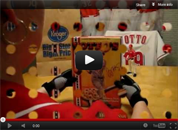Thanks and Good Luck, Bobby Livingston
Bobby Livingston is probably done for the season with a partially torn labrum in his pitching (left) shoulder. They haven't decided whether to operate, but if they do, that could take him out even longer.
Livingston has been a solid contributor to the Reds, though he did get roughed up pretty bad his last time out. Then again, with a partially torn labrum, maybe that's not so surprising.
He's currently on the 15-day DL and the team has brought back Mr. Sophomore Slump himself, Todd Coffey, to take his place. How in the world they think that Coffey fills the spot of the lefty starter who was scheduled to take the mound on Sunday, I cannot explain, but I'm hoping that Coffey has gotten his game together while with the Bats. He was going to be back with the team sooner than later anyway, as the minor league season is almost done.
Can you believe that? We're approaching our last month of baseball already. Time flies when you're constantly anticipating your team's next bonehead maneuver.
Sunday's pitcher is still up in the air. They're already having to recall Matt Belisle to start tomorrow. The options are many, and there isn't a standout choice. Hopefully the Reds' hot streak is so hot that it doesn't matter who they put on the mound in the same way that it didn't matter who they put in the outfield tonight.



The description of the symptoms of his injury that Livingston gave the beat writers, with reference to a “catch” in his range of motion, matches the variety of labrum damage that is the variation most often sustained by throwing athletes and is known as a SLAP tear (for superior lesion, anterior to posterior). The usual treatment for athletes is to arthroscopically clean up the tear, and then reattach the labrum to the shoulder and/or humerus using sutures in much the same way they sew up skin lacerations.
It’s circa six months after that to return to full activity, depending on surgeon preference and assuming there isn’t also damage to the rotator cuff or other shoulder problems.
When Livingston made his comments to the beat writers about all the work he does to try to stay in good condition, well, there’s really not much he could have done. The labrum is cartilage, not muscle, so unlike the rotator cuff (which is a group of four muscles and tendons), all the exercises in the world aren’t going to help strengthen it.
Basically, it’s an overuse injury. Reds’ pitching prospects must lead the league in this type of thing. 😥
Maybe they’ll bring back former Reds pitcher Brett Tomko. The Dodgers just DFA’ed Tomko and signed another ex-Red, David Wells, to replace him in their rotation after Wells was cut loose by the Padres recently. But I’d rather they give the starts to Gosling or EZ or Saarloos.
The Braves DFA’ed Wickman the day after Dunn’s walkoff dinger off him. It’ll be interesting to watch the Red Sox and Yankees fight over him. :rolleyes:
HMZ
I don’t think the Red Sox and Yankees will fight over Wickman. Look at his WHIP. He’s not very good. Do not be fooled by the ERA.
And it’s a cup of coffee for Coffey – he’s already been sent back down to make room for Belisle.
Really bad news about Livingston. Most pitchers [url=http://www.slate.com/id/2100895/]never return[/url] from this injury.
[quote]If pitchers with torn labrums were horses, they’d be destroyed. Of the 36 major-league hurlers diagnosed with labrum tears in the last five years, only midlevel reliever Rocky Biddle has returned to his previous level. Think about that when your favorite pitcher comes down with labrum trouble: He has a 3 percent chance of becoming Rocky Biddle. More likely, he’ll turn into Mike Harkey, Robert Person, or Jim Parque, pitchers who lost stamina and velocity—and a major-league career—when their labrums began to fray.[/quote]
Um, I guess Will Carroll forgot that Curt Schilling had surgery for a torn labrum in 1995 and came back better than ever?
According to [url=http://www.angelfire.com/vt/prospectwatch/index181.html]this[/url] interview with Dr. Frank Jobe, the orthopedic surgeon who pioneered the ulnar collateral ligament procedure now named after Tommy John, a pitcher who has torn the labrum probably has ligament and rotator cuff damage too. They can fix all that, but getting back to the same level of pitching afterward is another story.
The usual problem after a torn labrum seems to be loss of velocity. I guess that’s the good news for Livingston, who never depended on velocity to begin with. Plus, the Reds like post-torn labrum pitchers. See: Williams, Dave; See Also: Claussen, Brandon. <sigh>
He said “In the past five years.” 1995 is not the past five years, and wasn’t even when the article was written in 2004.
Some do come back. The chances just aren’t very good for a pitcher.
Fielders have better luck. So do quarterbacks, I guess. Drew Brees had a torn labrum.